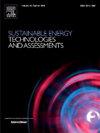新型冠状病毒肺炎前后N2O排放综合建模与定量分析——以广东省为例
IF 7
2区 工程技术
Q1 ENERGY & FUELS
Sustainable Energy Technologies and Assessments
Pub Date : 2025-04-13
DOI:10.1016/j.seta.2025.104313
引用次数: 0
摘要
N2O是最突出的温室气体之一,N2O排放的增加不仅会引发全球变暖,还会导致大气NOx水平过高和各种空气污染。国内外对N2O排放与资源利用关系的研究较少。基于排放源和数据可得性,构建了广东省能源利用N2O排放核算模型,并探讨了适用于行业减排的政策。我们发现,疫情导致的工业和交通活动减少导致N2O排放量显著减少,城市经济发展带来的垃圾燃烧是排放增长的重要来源,能源利用是2019 - 2021年N2O排放量的最大贡献者,由于社会恐慌导致的劳动力减少和社区严格执行遏制政策,N2O排放量明显下降。我们的模型强调了2020年新冠肺炎确诊病例与发电偏差率之间的负相关关系,强调新冠肺炎导致的劳动力减少是发电量减少的重要因素,这可能是固定源燃烧N2O排放量下降的重要诱因。本文章由计算机程序翻译,如有差异,请以英文原文为准。

Integrated modeling and quantitative analysis of N2O emission before and after COVID-19: A case in Guangdong Province
N2O is one of the most prominent greenhouse gases, and the increase in N2O emissions not only triggers global warming, but also leads to excessive atmospheric NOx levels and various air pollution. Research on the relationship between N2O emissions and resource utilization is scarce worldwide. We constructed an N2O emission accounting model for energy utilization based on emission sources and data availability in Guangdong Province, and explored the policies applicable to the sectoral emission reduction. We found that the pandemic-induced reduction in industrial and transportation activities resulted in a significant reduction of N2O emissions, waste combustion brought about by urban economic development is an important source of emission growth, energy utilization is the largest contributor to N2O emissions from 2019 to 2021, which has significantly dropped due to the reduction of labor force caused by social panic and the strict implementation of containment policies by the community. Our model highlighted a negative correlation between confirmed COVID-19 cases in 2020 and power generation deviation rates, emphasizing that the reduction of labor force caused by COVID-19 is a momentous factor for the decrease of power generation, which may be a prominence incentive for the fall of N2O emissions from fixed source combustion.
求助全文
通过发布文献求助,成功后即可免费获取论文全文。
去求助
来源期刊

Sustainable Energy Technologies and Assessments
Energy-Renewable Energy, Sustainability and the Environment
CiteScore
12.70
自引率
12.50%
发文量
1091
期刊介绍:
Encouraging a transition to a sustainable energy future is imperative for our world. Technologies that enable this shift in various sectors like transportation, heating, and power systems are of utmost importance. Sustainable Energy Technologies and Assessments welcomes papers focusing on a range of aspects and levels of technological advancements in energy generation and utilization. The aim is to reduce the negative environmental impact associated with energy production and consumption, spanning from laboratory experiments to real-world applications in the commercial sector.
 求助内容:
求助内容: 应助结果提醒方式:
应助结果提醒方式:


